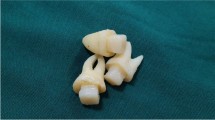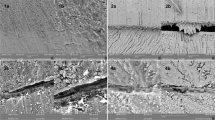Abstract
The aim of this study is to investigate the repair bond strength of composite resin following three different surface treatments (bur-grinding, silanization, and Er,Cr:YSGG laser irradiation) using various universal adhesives. A total of 160 resin composite specimens, produced in cylindrical form (6 × 2 mm) with a nanohybrid composite resin within metal molds, were subjected to 5000 cycles of aging in a thermocycler. The aged samples were categorized into four groups based on surface treatments: control, bur, silane, and Er,Cr:YSGG laser. Following surface treatments, the specimens underwent repair using the same resin composite and four different adhesive systems: Tokuyama Universal Bond (TUB), Prime Bond Universal (PBU), Gluma Bond Universal (GBU), and Clearfil SE Bond (CSB). Subsequently, the specimens were subjected to shear forces, and statistical analysis was performed using two-way ANOVA and Tukey tests (p < 0.05). The failure modes were examined using a stereomicroscope, and the surface topography of the roughened resin composite was assessed through scanning electron microscopy (SEM). Results indicated that silane + GBU exhibited the highest shear bond strength (SBS) (15.61 MPa) while control + TUB showed the lowest SBS (7.63 MPa). Silane demonstrated significantly higher SBS values (p ≤ 0.05), with no significant difference observed between bur and laser methods (p = 0.998). It is recommended to include an additional silanization step before applying universal adhesive, as it effectively enhances the bond strength of the repaired composite.





Similar content being viewed by others
Data availability
The datasets used and analyzed during the current study are available from the corresponding author on reasonable request.
References
Rashidi M, Berangi S, Chiniforush N, Ahmadi E, Ranjbar OL. Microtensile repair bond strength of a composite after accelerated artificial aging: effect of the air abrasion, bur, er:yag laser, two-step self-etch bonding, and universal bonding repair system. J Lasers Med Sci. 2022;25(13): e18.
Ástvaldsdóttir Á, Dagerhamn J, van Dijken JW, Naimi-Akbar A, Sandborgh-Englund G, Tranæus S, Nilsson M. Longevity of posterior resin composite restorations in adults–a systematic review. J Dent. 2015;43(8):934–54.
Gupta S, Parolia A, Jain A, Kundabala M, Mohan M, de Moraes Porto IC. A comparative effect of various surface chemical treatments on the resin composite-composite repair bond strength. J Indian Soc Pedod Prev Dent. 2015. https://doi.org/10.4103/0970-4388.160402.
Furtado MD, Immich F, WL de O da Rosa, E Piva, and AF da Silva. Repair of aged restorations made in direct resin composite–a systematic review. Int J Adhes. 2023. https://doi.org/10.1016/j.ijadhadh.2023.103367.
Alagoz LG, Calıskan A. Intraoral repair of dental restorations with resin composite. Cyprus J Med Sci. 2022;7:431–7.
Almutairi MA, Salama FS, Alzeghaibi LY, Albalawi SW, Alhawsawi BZ. Surface treatments on repair bond strength of aged resin composites. J Int Soc Prev Commun Dent. 2022;12(4):449–55.
Stape THS, Tulkki O, Salim IA, Jamal KN, Mutluay MM, Tezvergil-Mutluay A. Composite repair: On the fatigue strength of universal adhesives. Dent Mater. 2022;38(2):231–41.
Celiksoz O, Yilmaz NA, Balin E. Effect of Er: YAG laser on repair bond strength of a nanohybrid composite. J Stomatol. 2022;75:122–9.
Kaptan A, Oznurhan F. Effects of Er:YAG and Er, Cr:YSGG laser irradiation and adhesive systems on microtensile bond strength of a self-adhering composite. Lasers Med Sci. 2023;38(1):41.
Kimyai S, Mohammadi N, Navimipour EJ, Rikhtegaran S. Comparison of the effect of three mechanical surface treatments on the repair bond strength of a laboratory composite. Photomed Laser Surg. 2010;28(Suppl 2):S25-30.
Duran I, Ural C, Yilmaz B, Tatar N. Effects of Er:YAG laser pretreatment with different energy levels on bond strength of repairing composite materials. Photomed Laser Surg. 2015;33(6):320–5.
Irmak O, Ozdil O, Yılmaz B, Yaman BC. Adhesive system affects repair bond strength of resin composite. J Istanbul Univ Fac Dent. 2017;51:25–31.
Wagner A, Wendler M, Petschelt A, Belli R, Lohbauer U. Bonding performance of universal adhesives in different etching modes. J Dent. 2014;42(7):800–7.
Rosa WL, Piva E, Silva AF. Bond strength of universal adhesives: a systematic review and meta-analysis. J Dent. 2015;43(7):765–76.
Yoshihara K, Nagaoka N, Sonoda A, Maruo Y, Makita Y, Okihara T, Irie M, Yoshida Y, Van Meerbeek B. Effectiveness and stability of silane coupling agent incorporated in ‘universal’ adhesives. Dent Mater. 2016;32(10):1218–25.
Yin H, Kwon S, Chung SH, Kim RJY. Performance of universal adhesives in composite resin repair. Biomed Res Int. 2022;9(2022):7663490.
Ayar MK, Guven ME, Burduroglu HD, Erdemir F. Repair of aged bulk-fill composite with posterior composite: effect of different surface treatments. J Esthet Restor Dent. 2019;31(3):246–52.
Eren D, Dogan CA, Bektas OO. Effect of different surface treatments and roughness on the repair bond strength of aged nanohybrid composite. Photobiomodul Photomed Laser Surg. 2019;37(8):473–82.
Batista GR, Kamozaki MB, Gutierrez NC, Caneppele TM, Torres RG. Effects of different surface treatments on composite repairs. J Adhes Dent. 2015;17(5):421–6.
Frencken JE, Peters MC, Manton DJ, Leal SC, Gordan VV, Eden E. Minimal intervention dentistry for managing dental caries–a review: report of a FDI task group. Int Dent J. 2012;62(5):223–43.
Estay J, Martín J, Viera V, Valdivieso J, Bersezio C, Vildosola P, Mjor IA, Andrade MF, Moraes RR, Moncada G, Gordan VV, Fernández E. 12 years of repair of amalgam and composite resins: a clinical study. Oper Dent. 2018. https://doi.org/10.2341/16-313-C.
Casagrande L, Laske M, Bronkhorst EM, Huysmans MCDNJM, Opdam NJM. Repair may increase survival of direct posterior restorations–a practice based study. J Dent. 2017. https://doi.org/10.1016/j.jdent.2017.06.002.
Fernández E, Martín J, Vildósola P, Oliveira Junior OB, Gordan V, Mjor I, Bersezio C, Estay J, de Andrade MF, Moncada G. Can repair increase the longevity of composite resins? Results of a 10 year clinical trial. J Dent. 2015;43(2):279–86.
Ozcan M, Pekkan G. Effect of different adhesion strategies on bond strength of resin composite to composite-dentin complex. Oper Dent. 2013. https://doi.org/10.2341/11-482-L.
Barcellos DC, Miyazaki Santos VM, Niu LN, Pashley DH, Tay FR, Pucci CR. Repair of composites: Effect of laser and different surface treatments. Int J Adhes Adhes. 2015. https://doi.org/10.1016/j.ijadhadh.2015.01.008.
Ozel Bektas O, Eren D, Herguner Siso S, Akın GE. Effect of thermocycling on the bond strength of composite resin to bur and laser treated composite resin. Lasers Med Sci. 2012;27(4):723–8.
Demirel G, Gur G. Micro-shear bond strength of aged resin composite repaired with different universal adhesives. Meandros Med Dent J. 2019;20:7–12.
Moszner N, Salz U, Zimmermann J. Chemical aspects of self-etching enamel-dentin adhesives: a systematic review. Dent Mater. 2005;21(10):895–910.
Loomans B, Ozcan M. Intraoral repair of direct and indirect restorations: procedures and guidelines. Oper Dent. 2016;41(S7):S68–78.
Michelotti G, Niedzwiecki M, Bidjan D, Dieckmann P, Deari S, Attin T, Tauböck TT. Silane effect of universal adhesive on the composite-composite repair bond strength after different surface pretreatments. Polymers (Basel). 2020;12(4):950.
Neto HNM, Leite JVC, de Medeiros JM, Silva Campos D, de Araújo Ferreira Muniz I, De Andrade AKM, Duarte RM, De Souza GM, Lima RBW. Scoping review: effect of surface treatments on bond strength of resin composite repair. J Dent. 2024. https://doi.org/10.1016/j.jdent.2023.104737.
Leelaponglit S, Maneenacarith A, Wutikhun T, Klaisiri A. The various silane agents in universal adhesives on repair strength of resin composite to resin composite. J Compos Sci. 2023;7(1):7.
Hadilou M, Dolatabadi A, Ghojazadeh M, Hosseinifard H, Alizadeh Oskuee P, Pournaghi AF. Effect of different surface treatments on the long-term repair bond strength of aged methacrylate-based resin composite restorations: a systematic review and network meta-analysis. Biomed Res Int. 2022;5(2022):7708643.
Bahadir HS, Polatoglu S, Tuncer D, Celik C. The comparison of the repair bond strength of the composite resin to direct and indirect composite restorations with different surface preparations. J Dent Res Dent Clin Dent Prospect. 2023. https://doi.org/10.34172/joddd.2023.35422.
Staxrud F, Dahl JE. Silanising agents promote resin-composite repair. Int Dent J. 2015;65(6):311–5.
Ugurlu M, Al-Haj Husain N, Özcan M. Repair of bulk-fill and nanohybrid resin composites: effect of surface conditioning, adhesive promoters, and long-term aging. Materials (Basel). 2022;15(13):4688.
Jusué-Esparza G, Rivera-Gonzaga JA, Grazioli G, Monjarás-Ávila AJ, Zamarripa-Calderón JE, Cuevas-Suárez CE. Influence of silane coupling agent and aging on the repair bond strength of dental composites. J Adhes Sci Technol. 2023;37:913–22.
Carrilho E, Cardoso M, Marques Ferreira M, Marto CM, Paula A, Coelho AS. 10-MDP based dental adhesives: adhesive ınterface characterization and adhesive stability-a systematic review. Materials (Basel). 2019;12(5):790.
Tsujimoto A, Fischer NG, Barkmeier WW, Latta MA. Bond durability of two-step hema-free universal adhesive. J Funct Biomater. 2022;13(3):134.
Phrukkanon S, Burrow MF, Hartley PG, Tyas MJ. The influence of the modification of etched bovine dentin on bond strengths. Dent Mater. 2000;16(4):255–65.
Albuquerque M, Pegoraro M, Mattei G, Reis A, Loguercio AD. Effect of double-application or the application of a hydrophobic layer for improved efficacy of one-step self-etch systems in enamel and dentin. Oper Dent. 2008. https://doi.org/10.2341/07-145.
Taschner M, Kümmerling M, Lohbauer U, Breschi L, Petschelt A, Frankenberger R. Effect of double-layer application on dentin bond durability of one-step self-etch adhesives. Oper Dent. 2014. https://doi.org/10.2341/13-168-L.
Cakir NN, Demirbuga S, Balkaya H, Karadas M. Bonding performance of universal adhesives on composite repairs, with or without silane application. J Conserv Dent. 2018. https://doi.org/10.4103/JCD.JCD_11_18.
El-Askary FS, El-Banna AH, van Noort R. Immediate vs delayed repair bond strength of a nanohybrid resin composite. J Adhes Dent. 2012;14(3):265–74.
Khosravanifard B, Nemati-Anaraki S, Faraghat S, Sajjadi SH, Rakhshan H, Rakhshan V. Efficacy of 4 surface treatments in increasing the shear bond strength of orthodontic brackets bonded to saliva-contaminated direct composites. Orthod Waves. 2011;70:65–70.
Joulaei M, Bahari M, Ahmadi A, Savadi OS. Effect of different surface treatments on repair micro-shear bond strength of silica and zirconia-filled composite resins. J Dent Res Dent Clin Dent Prospects. 2012;6(4):131–7.
Celik EU, Ergucu Z, Turkun LS, Ercan UK. Tensile bond strength of an aged resin composite repaired with different protocols. J Adhes Dent. 2011;13(4):359–66.
Murray AK, Attrill DC, Dickinson MR. The effects of XeCl laser etching of Ni-Cr alloy on bond strengths to composite resin: a comparison with sandblasting procedures. Dent Mater. 2005;21(6):538–44.
Kuhn K, Schmid CU, Luthardt RG, Rudolph H, Diebolder R. Er:YAG laser-induced damage to a dental composite in simulated clinical scenarios for inadvertent irradiation: an in vitro study. Lasers Med Sci. 2022;37(2):1017–30.
Alizadeh Oskoee P, Kimyai S, Talatahari E, Rikhtegaran S, Pournaghi-Azar F, Sajadi OJ. Effect of mechanical surface treatment on the repair bond strength of the silorane-based composite resin. J Dent Res Dent Clin Dent Prospect. 2014;8(2):61–6.
Isolan CP, Moreira AG, Ribeiro JS, Nakanishi L, Cuevas-Suárez CE. Effect of different adhesive protocols on bond strength between composite resins for indirect use and repair materials. J Adhes Sci Technol. 2020;34(1):67–75.
Erbulak Z, Ergun G. The effects of different surface treatments applied to milled PMMA denture base material on repair bond strength. Odontology. 2023;111(4):953–70.
Cuevas-Suárez CE, Nakanishi L, Isolan CP, Ribeiro JS, Moreira AG, Piva E. Repair bond strength of bulk-fill resin composite: effect of different adhesive protocols. Dent Mater J. 2020;39(2):236–41.
Acknowledgements
The authors affirm that they do not have any conflicts of interest related to this study. The authors would like to thank Middle East Technical University Central Laboratory and Mustafa YESIL, who works in the Ankara University Faculty of Dentistry Research Laboratory, for her valuable assistance during the experiments.
Author information
Authors and Affiliations
Corresponding author
Ethics declarations
Conflict of interest
The authors declare that they have no competing interests.
Additional information
Publisher's Note
Springer Nature remains neutral with regard to jurisdictional claims in published maps and institutional affiliations.
Rights and permissions
Springer Nature or its licensor (e.g. a society or other partner) holds exclusive rights to this article under a publishing agreement with the author(s) or other rightsholder(s); author self-archiving of the accepted manuscript version of this article is solely governed by the terms of such publishing agreement and applicable law.
About this article
Cite this article
Dogan, E., Cevval Ozkocak, B.B. The efficacy of Er,Cr:YSGG laser and contemporary universal adhesive systems on composite resin repair bond strength: an in vitro study. Odontology (2024). https://doi.org/10.1007/s10266-024-00932-2
Received:
Accepted:
Published:
DOI: https://doi.org/10.1007/s10266-024-00932-2




